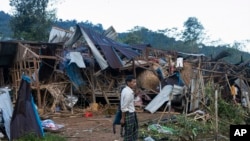Three years after Myanmar’s military junta overthrew the country’s democratically elected government, the U.N.’s top human rights official is calling on the international community to redouble efforts “to hold the military accountable” for the many crimes and abuses it has committed against the country’s civilian population.
“Myanmar’s ever deteriorating human rights crisis is now in freefall, with insufficient world attention paid to the misery and pain of its people,” Volker Türk, U.N. high commissioner for human rights, said in a statement issued Tuesday.
“Amid all of the crises around the world, it is important no one is forgotten. The people of Myanmar have been suffering for too long,” he said.
Ahead of the anniversary of the military coup February 1, 2021, the high commissioner said that “pitched battles between the military and armed opposition groups have resulted in mass displacement and civilian casualties” and as the military has suffered multiple setbacks on the battlefield, it has lashed out by launching “waves of indiscriminate aerial bombardments and artillery strikes.”
According to the U.N. Office of the High Commissioner for Human Rights, credible sources in Myanmar have verified that more than 554 people have died since October, when an alliance of three ethnic armed groups mounted an offensive against the military. Overall last year, 1,600 civilians reportedly have been killed by the military.
As of January 26, the sources have documented the arrests of nearly 26,000 people on political grounds—of whom 19,973 remain in detention, “some reportedly subjected to torture and abuses, and with no hope of a fair trial.” Over the last three years, it says some 1,576 individuals “have died while being held by the military.”
The October offensive by the alliance of ethnic armed groups has emerged as the biggest threat to Myanmar’s military coup leaders. This reportedly persuaded the junta to accept a cease-fire agreement with the armed groups brokered by China on January 12th.
“The fighting has subsided to a large degree,” said James Rodehaver, head of the U.N. Human Rights Office Myanmar Team. “However, there still continues to be airstrikes and some artillery barrages by the military against positions by these three-armed groups,”
Speaking from Bangkok Tuesday, Rodehaver said “the armed groups have made it very clear that the cease-fire has repeatedly been violated by the Myanmar military…There still are instances where civilians are being killed as a result of these barrages.”
He noted that the armed groups are in control of the areas they have captured and, in some cases, have handed over the administration of some towns and villages to the civilian inhabitants.
“We are quite keen to see what impact that has had and also, of course, whether or not humanitarian access is going to expand in those areas and that the needs of the civilian population are going to be cared for,” he said.
High Commissioner Türk says that Rakhine State has been particularly hard hit since fighting restarted there in November. He said, “Many communities, especially the Rohingya, were already suffering from the impacts of Cyclone Mocha and the military’s months-long limitation of humanitarian access and provision of assistance.
“There have now been several reports of Rohingya deaths and injuries amid the military’s shelling of Rohingya villages,” he said, noting that fighting between the Arakan Army and the Myanmar military on January 26 “reportedly left at least 12 Rohingya civilians dead and 30 others wounded.”
Rodehaver notes there are very few places to where people can flee. “The Rohingya have very limited options, which is one of the reasons why so many are trying to find any way to get out and into a safe location. And that includes even trying to flee on unseaworthy boats either directly from Myanmar or out of Cox’s Bazaar,” he said.
The U.N. refugee agency, UNHCR, says 569 Rohingya perished or disappeared last year in Southeast Asian waters, with nearly 4,500 embarking on deadly sea journeys—the highest number since 2014, when the total reached 730.
“Estimates show one Rohingya was reported to have died or gone missing for every eight people attempting the journey in 2023,” said Matthew Saltmarsh, UNHCR spokesperson. “This makes the Andaman Sea and Bay of Bengal one of the deadliest stretches of water in the world.”
The UNHCR says that most of those embarking on deadly unseaworthy journeys are refugees departing from Cox’s Bazaar. Bangladesh, where more than a million refugees who fled violence and persecution in Myanmar in August 2021 are living in cramped, overcrowded camps.








